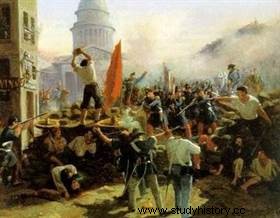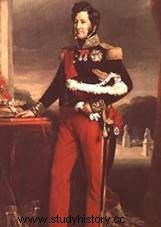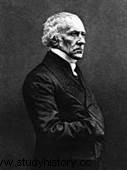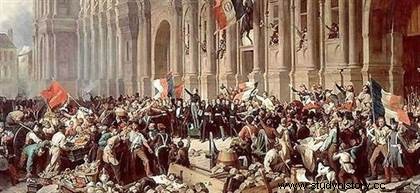 Following the banning of the Republican Banquets campaign by Guizot, the revolution broke out from 22 to February 25, 1848 , resulting in the abdication of King Louis-Philippe and the fall of the July Monarchy. A republican provisional government is set up, it is the birth of the Second Republic . This flash revolution, which took many politicians by surprise, saw the union in opposition to Orléans, of republicans of conviction with those who had sometimes rallied from the legitimist movement. The February Revolution of 1848 will become a reference for the Republican family, an active memory which rebounds sporadically in the history of the Republican conquest and in that of the French left.
Following the banning of the Republican Banquets campaign by Guizot, the revolution broke out from 22 to February 25, 1848 , resulting in the abdication of King Louis-Philippe and the fall of the July Monarchy. A republican provisional government is set up, it is the birth of the Second Republic . This flash revolution, which took many politicians by surprise, saw the union in opposition to Orléans, of republicans of conviction with those who had sometimes rallied from the legitimist movement. The February Revolution of 1848 will become a reference for the Republican family, an active memory which rebounds sporadically in the history of the Republican conquest and in that of the French left.
The causes of the 1848 revolution
The February Revolution resulted primarily from political causes. These reflected the gradual wear and tear of the July Monarchy resulting from the Trois Glorieuses , which was proving increasingly incapable of managing the contradiction from which it was born, between the aspirations for a liberal and bourgeois Order embodied by a Guizot or a Thiers and the aspirations for a universal democracy that had been defended on the barricades the revolutionaries of 1830. The prohibition of republican banquets where the republic was celebrated, universal suffrage and electoral reform set fire to the powder, raising important popular demonstrations mainly in Paris.
As early as 1846, the poor harvest and the resulting agricultural crisis — added to the destabilization of industrial and financial markets — led to a short-term and economic crisis. Its social consequences are disastrous for the underprivileged layers, in particular for the urban proletariat; rising prices (especially bread), potato disease, high cost of raw materials for traditional crafts, illness and unemployment then feed social discontent.
 But the crisis is also structural and political. The emergence of workers as a social group - living in job insecurity and undergoing the mechanization of tasks - is an important change in society. Because it is abused and victim of impoverishment, this social group is more and more imbued with democratic and socialist ideals. At the same time, the petty and middle bourgeoisie is frustrated with a political system that essentially benefits the big business bourgeoisie; it aspires for its part to a real egalitarianism, that of universal suffrage while, for the time being, the voter's cens (200 francs) and eligibility (500 francs) remain too selective. Finally, the youth (of the universities) and the republican intellectual elites are turning away from official liberalism which only serves the notables. Their hallmarks, steeped in revolutionism, are “freedom” and “equality”.
But the crisis is also structural and political. The emergence of workers as a social group - living in job insecurity and undergoing the mechanization of tasks - is an important change in society. Because it is abused and victim of impoverishment, this social group is more and more imbued with democratic and socialist ideals. At the same time, the petty and middle bourgeoisie is frustrated with a political system that essentially benefits the big business bourgeoisie; it aspires for its part to a real egalitarianism, that of universal suffrage while, for the time being, the voter's cens (200 francs) and eligibility (500 francs) remain too selective. Finally, the youth (of the universities) and the republican intellectual elites are turning away from official liberalism which only serves the notables. Their hallmarks, steeped in revolutionism, are “freedom” and “equality”.
From the wear and tear of social structures to the refusal of the supremacies established by the monarchy, the crisis is therefore deeply political, but also moral. The patent decline of monarchical sentiment, linked to the repressive and ultra-conservative authoritarianism of Louis-Philippe's ministers (led by Guizot), reinforced by the lack of political freedoms (limitation of the freedoms of the press and assembly), completes the destabilization of the regime. A significant part of the nation perceives its legitimacy less and less. However, Louis-Philippe does not discern the depth of the fracture that crosses the country and lets his ministry prevent any electoral reform likely to appease the discontented.
The banquets campaign
The dispute between the country and the state is highlighted by the "Banquet campaign". Launched on July 9, 1847, the campaign brought together all the Republican opposition around a single demand:electoral reform. During these protest banquets, which sometimes bring together several thousand guests, tradition dictates that we toast to reform – long toasts, long enough to turn into a speech. Through this subterfuge, the campaign continues to gain in scope and success, despite the bans imposed by the Guizot ministry.
 On February 12, 1848, Guizot and the majority of the House rejected the Sallandrouze amendment, which called on the government to initiate “wise, moderate, parliamentary” reforms. In reaction, the opposition decides to protest by organizing a last and gigantic banquet in Paris, on the 22nd of the same month. But from February 14, Guizot, inflexible, informed the organizing committee that he forbade the holding. The latter, however, maintained the demonstration but, when the 21 Guizot reiterated its veto and mobilized the troops, some organizers sought to stop the escalation and canceled the banquet.
On February 12, 1848, Guizot and the majority of the House rejected the Sallandrouze amendment, which called on the government to initiate “wise, moderate, parliamentary” reforms. In reaction, the opposition decides to protest by organizing a last and gigantic banquet in Paris, on the 22nd of the same month. But from February 14, Guizot, inflexible, informed the organizing committee that he forbade the holding. The latter, however, maintained the demonstration but, when the 21 Guizot reiterated its veto and mobilized the troops, some organizers sought to stop the escalation and canceled the banquet.
Leader of the dynastic left and main initiator of the banquets, Odilon Barrot declares for his part that "the chariot is launched and whatever we do the people will be in the streets tomorrow". It is indeed too late; students from the Latin Quarter and workers from the suburbs are already parading at the call of secret societies and advancing towards Concorde. A first skirmish takes place with the military.
The February Revolution of 1848
On February 22, 1848, Guizot asked the Paris National Guard to repress the troublemakers; but, although it had excelled in this role since 1830, the Guard did not act. The demonstrators demand the resignation of the Soult-Guizot ministry and political reform.
On the evening of February 23, while revolutionary fever spread to certain ranks of the army and the National Guard marched into the camp of the insurgents to cries of "Vive la Réforme" , about fifty demonstrators decide to boo Guizot under the windows of the Ministry of Foreign Affairs. This time, the troops fired, leaving several dead on the Boulevard des Capucines. Transported on carts, the remains are exhibited throughout the capital. This "promenade of the corpses" triggers the insurrection itself, against which the police do not dare to intervene.
 In the night, the government no longer faces a riot, but a revolution with barricades, battles of streets and shootings. Asked to replace Thiers, Odilon Barrot slips away again. During this time, the insurgents take the Hôtel de Ville and the Tuileries Palace; sixteen of them fall under the bullets of the troop.
In the night, the government no longer faces a riot, but a revolution with barricades, battles of streets and shootings. Asked to replace Thiers, Odilon Barrot slips away again. During this time, the insurgents take the Hôtel de Ville and the Tuileries Palace; sixteen of them fall under the bullets of the troop.
The advent of the Second Republic
The National Guard fraternizing with the demonstrators, Guizot resigned amid immense popular jubilation. Louis-Philippe then abdicated in favor of his nine-year-old grandson, the Count of Paris. But the rioters had already taken over the Bourbon Palace where the deputies sat and were pressing for the proclamation of the Second Republic , which was done at the same time as a list of names was drawn up to constitute a provisional government. At the same time, the rioters had also seized the Hôtel de Ville and, there too, a list of possible governors was prepared. Finally, the provisional government had eleven names, including that of Lamartine was arguably the most famous. This is the beginning of the short-lived "romantic" republic.
The Second Republic was originally intended to be a modern and ambitious regime, quite characteristic of the revolutionary effervescence that shook Europe at the time. great symbolic measures were adopted such as the abolition of slavery, the proclamation of freedom of the press and of assembly, the proclamation of universal male suffrage, the creation of national building sites, etc. Promising regime, which nevertheless collapsed in barely two years, put to death by the one who should have been its protector, namely its President:Louis Napoleon Bonaparte.
Bibliography
- 1848, the forgotten revolution, by Michèle RIOT-SARCEY and Maurizio GRIBAUDI. Discovery, 2009.
- History of the Revolution of 1848, by Alphonse De Lamartine. Wentworth Press, 2019.
